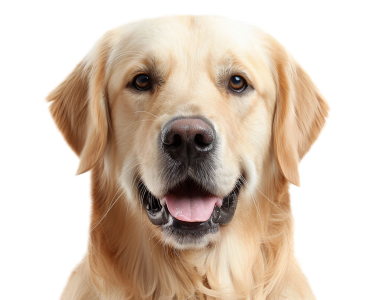Antler chews from deer, elk, and fallow deer are a natural source of calcium, phosphorus, and other essential minerals needed for your dog’s bone and dental health. Chewing on antlers supports oral hygiene by helping to remove plaque and massage the gums. Additionally, these chews satisfy a dog’s natural instinct to gnaw, reduce stress, and provide long-lasting entertainment. Due to their durability, antlers are an ideal choice for dogs of all ages and activity levels.
Questions & Answers
Why Antler Chews Are Healthy for Dogs?
Which Dogs Should Chew Antlers?
Antler chews are perfect for dogs with strong jaws that need durable toys to satisfy their natural chewing instincts. An experienced chewer is a dog that regularly chews harder materials like bones or tough toys and handles them without any issues. These chews are especially recommended for medium and large breeds that can benefit from their durability. Dogs that enjoy long-lasting chews often choose antlers because they are natural, rich in calcium, phosphorus, and other nutrients that support dental and bone health.
At What Age Should Dogs Start Chewing Antlers?
Antler chews are not recommended for very young puppies. Dogs should be at least 6-8 months old before they start using antler chews, as their teeth and jaws need to be fully developed to handle the hardness of the material. For younger dogs, it’s best to start with softer chews and introduce antlers only after consulting with a veterinarian. Split antlers, where the softer inner core is exposed, are easier to chew and safer for younger dogs.
Which Dogs Should Not Chew Antlers?
Antler chews are not suitable for all dogs. Avoid giving them to dogs with delicate teeth, including puppies under 6 months, seniors, and dogs with dental issues such as sensitive gums or damaged teeth. The hardness of antlers can lead to tooth fractures, which are not only painful but also expensive to treat. Dogs that tend to chew aggressively may swallow antler fragments, which can cause digestive issues like blockages in the digestive tract. In such cases, it’s better to opt for other, softer chew options like dried pig ears, bully sticks, or soft dental chews.
How to Safely Give Antlers to Your Dog?
Antler chews are an excellent choice for dogs that love to chew for extended periods. To ensure safety:
- Choose the Right Size: Make sure the antler chew is appropriately sized for your dog’s size and chewing strength. A chew that is too small could pose a choking hazard, while one that is too large may be difficult to handle.
- Supervise Your Dog: Always watch your dog while they chew an antler, especially the first time you give it. Stop the activity if your dog becomes too aggressive in their chewing or attempts to swallow large pieces.
- Check the Condition of the Chew: Regularly inspect the antler chew. If it begins to splinter or becomes too small, remove it immediately to prevent the risk of swallowing sharp fragments.
Should You Boil an Antler Before Giving It to Your Dog?
Yes, placing the antler chew in hot water for a few minutes before offering it to your dog can offer several benefits:
- Eliminating Bacteria: Brief boiling can help remove any bacteria on the antler’s surface, providing extra health safety for your dog.
- Enhancing Scent and Flavor: Heating the antler can bring out its natural scent, making it more appealing to your dog. Softening the outer layer can also make it easier to access the core, increasing its palatability.
- Softening the Outer Layer: A quick heat treatment can slightly soften the outer layer of the antler, making it easier to chew, especially for younger or less experienced chewers.
Be sure not to boil the antler for too long, as this can make it brittle, increasing the risk of fractures and sharp edges. After removing the antler from the water, always allow it to cool before giving it to your dog to avoid burns.
How to choose the right size of antler chew for your dog?
Choosing the right size antler chew is crucial for your dog’s safety and enjoyment. Each size is tailored to your dog’s weight and chewing strength, ensuring a long-lasting and safe chewing experience.
Sizes and Weight Ranges:
- Size S (Small):
- Dog Weight: 5-15 pounds (approx. 2-7 kg)
- Chew Length: 4-6 inches (approx. 10-15 cm)
- Weight Range: Typically around 40-70 grams
- Breed Examples: Chihuahua, Shih Tzu, Papillon, Pomeranian, Yorkshire Terrier, Pug, Toy Poodle, Maltese, Miniature Pinscher, Dachshund (miniature), Havanese, Bichon Frisé.
- Size M (Medium):
- Dog Weight: 15-35 pounds (approx. 7-16 kg)
- Chew Length: 5-7 inches (approx. 13-18 cm)
- Weight Range: Around 70-120 grams
- Breed Examples: Beagle, Border Collie, Corgi, Boston Terrier, Cocker Spaniel, Shetland Sheepdog, French Bulldog, Basset Hound, Whippet, Miniature Schnauzer, Shiba Inu, Miniature Australian Shepherd, Medium Poodle.
- Size L (Large):
- Dog Weight: 35-65 pounds (approx. 16-29 kg)
- Chew Length: 7-9 inches (approx. 18-23 cm)
- Weight Range: Around 120-180 grams
- Breed Examples: Labrador Retriever, Golden Retriever, Boxer, Dalmatian, Siberian Husky, Australian Shepherd, German Shorthaired Pointer, English Bulldog, Irish Setter, Staffordshire Bull Terrier, Alaskan Malamute, Shar Pei, Vizsla, Rhodesian Ridgeback.
- Size XL (Extra Large):
- Dog Weight: 65-95 pounds (approx. 29-43 kg)
- Chew Length: 8-10 inches (approx. 20-25 cm)
- Weight Range: Around 180-250 grams
- Breed Examples: German Shepherd, Rottweiler, Akita, Bernese Mountain Dog, Great Pyrenees, Doberman Pinscher, Cane Corso, Newfoundland, Old English Sheepdog, Belgian Malinois, Mastiff, Saint Bernard, Irish Wolfhound, Bullmastiff.
- Size XXL (Extra Extra Large):
- Dog Weight: Over 95 pounds (approx. 43 kg)
- Chew Length: 9-12 inches (approx. 23-30 cm)
- Weight Range: Around 250-350 grams
- Breed Examples: Great Dane, Mastiff, Saint Bernard, Newfoundland, Irish Wolfhound, Bernese Mountain Dog, Scottish Deerhound, Leonberger, Tibetan Mastiff, Anatolian Shepherd Dog, Pyrenean Mountain Dog, Kuvasz, Caucasian Shepherd Dog.
Why the Right Size Matters?
Choosing the correct size ensures that your dog can enjoy safe and long-lasting chewing. A chew that is too small can be a choking hazard, while one that is too large may be difficult for your dog to handle. The right size chew tailored to your dog’s weight and strength ensures optimal health benefits, including dental and gum health, while satisfying their natural chewing instincts.
Tips for Choosing a Chew:
- If your dog is on the upper end of the weight range for a size or is an aggressive chewer, consider selecting a chew one size larger to ensure it lasts longer.
- Regular
How long should a dog chew on an antler?
It’s important to limit the time your dog spends chewing on an antler to prevent excessive tooth wear or gum irritation. Generally, 30 minutes per session is a good guideline. Always supervise your dog and remove the chew if they start to become overly aggressive or if the antler begins to splinter.
Is split antler better than whole antler?
Split antlers have the inner marrow exposed, which is softer and can be more appealing to some dogs, especially those new to antler chews or with less aggressive chewing habits. Whole antlers are tougher and last longer, making them a better choice for more aggressive chewers.
Can antler chews spoil or expire?
Antler chews don’t really expire like other dog treats, but they can dry out further over time, making them even harder. It’s important to store them in a cool, dry place and check them regularly for cracks or sharp edges before giving them to your dog.
What Should I Do If My Dog Swallows a Piece of an Antler?
If your dog swallows a piece of an antler, closely monitor them for signs of distress, such as vomiting, loss of appetite, or lethargy. If you notice any of these signs, contact your vet immediately. Choosing an appropriately sized antler and supervising your dog during chew time can minimize this risk.
Are Antler Chews Safe for All Breeds?
While antlers can be safe for many breeds, they are not suitable for all dogs, especially those with dental issues or very strong chewers who may risk fracturing their teeth. It’s always a good idea to consult with your veterinarian before introducing antler chews to your dog.


Join our distributors
